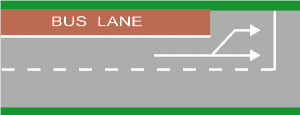The diagram shows the layout of the most common type of bus set-back, and it is straightforward to model.

Traffic Stream network structure (TRANSYT 16):
The buses can be modelled on a bus lane using a separate traffic stream. Simply specify the traffic stream “traffic type” as “Bus” and set the bus stopped time and (bus) average cruise speed. The flow is just the buses flowing along that bus lane.
A setback looks like a flared approach to non-bus traffic and can be modelled as such. The average utilisation of the ‘bay’ needs to be estimated. Buses will start off later as a result of having to wait for any traffic in front to discharge. This can be modelled easily with a “green start adjustment” on the bus traffic stream (within the “Signals” tab of the “Traffic Streams” data screen). This will be approximately 2 seconds per vehicle that has been estimated as queuing in front of the bus on average.
Link Network Structure (TRANSYT 16):
The first important point to note is that two separate links should be used – one for each lane. This is not a scenario where shared links (a ‘link-share’) can be used, as the two lanes have very different uses. You need to set the “Traffic type” of the link representing the bus lane to “Bus”. This will then allow you to enter (under the Link Data screen “Flows” tab > “Sources” tab) the bus “free running speed (or time)” and “stationary time”, i.e. the time spent at bus stop(s).
Next, the link for the other traffic takes the form of a flared approach and can be modelled as such in TRANSYT. Decide how many vehicles, on average, will use the space between the end of the bus lane and the stop line; then estimate the saturation flow of the short lane or bay (TRANSYT is not especially sensitive to this value). Enter these into the TRANSYT model.
Finally, you need to add a “green start adjustment” (see the “Signals” tab) to take account of the time it will take (again on average) for the first bus to cross the stop line after the start of green. This will be about two-seconds for each vehicle between the bus and the stop line.
Earlier versions of TRANSYT (prior to TRANSYT 16.1.4): Traffic Stream and Link “Green start adjustments” do not exist, so contact TRL Software for details on how to make the necessary equivalent green time adjustments to the model.